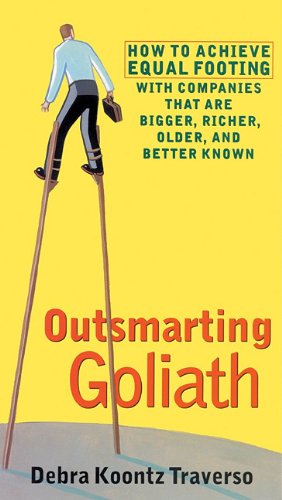Items related to Outsmarting Goliath: How to Achieve Equal Footing with...
Outsmarting Goliath: How to Achieve Equal Footing with Companies That Are Bigger, Richer, Older, and Better Known

Outsmarting Goliath confronts this paradox: Many of today’s consumers—potential customers—turn automatically to brand name products and services, forgetting that the well-advertised brontosauruses often deliver one-of-our-sizes-fits-all service and impersonal sales help. Yet a single phone call, a cleverly crafted letter, a stunning catalog, winning ad, or a well-prepared face-to-face presentation can change a customer’s perception. In those crucial situations, the small up-starter can use the tips in this book to capture more clients and give Goliath a headache. Highlights include:
Choosing a name and location that bolster consumer confidence Projecting a big image without hiring more employees Capitalizing on the Internet as an equalizer"synopsis" may belong to another edition of this title.
Debra Koontz Traverso teaches crisis management and prevention as an adjunct professor at Harvard University. She is a small-business consultant serving as the small-business expert for Workingwoman.com. Her book, Outsmarting Goliath, provides strategies to help small businesses defeat larger competitors. Traverso is copresident of WriteDirections.com, a company that offers consulting and teleclasses in business and personal writing. She lives in the Washington, DC, area.
Your business—like all businesses—projects an image of some sort whether you are aware of it or not. Awareness is your first step toward having control. Let's look at five factors that influence your image:
1. Your company logistics.
Logistics include your industry, your size and structure, the number of employees you have, your location, how your store or office looks and sounds, the products or services you provide, and how much you interact with the community and your clients. Without even knowing you, people have a preconceived impression of your business. This preconception, if favorable, works to a small business owner's advantage, because people have a better idea of what they might encounter through their patronage. When companies become chain operations, their scope changes and their product line or list of services begins to shift; customers are no longer sure what to expect. Often people will stick with the reliable and the familiar, provided the smaller company makes it worth their while by keeping all other factors—such as customer service, price, and quality—equal to or better than those of the growing competition.
2. Your uniqueness and how you differentiate yourself from the competition.
In item one, I said that being consistent and fulfilling customers' preconceived notions was good, and now I'm saying you have to be unique. How can you do both? Let's say you run a bookstore. People have an idea of what to expect from a bookstore, and you shouldn't let them down. They want to find a selection of books categorized under subject headings in a brightly lit store. And nowadays, they might also expect a place to sit down and have a cup of coffee. What they won't expect but will be pleased to discover is a place to hang their coats and stash their bags so their hands are free to leaf through potential purchases. They might not expect access to the Internet to look up reviews of a book. (Even if you have to log onto Amazon.com so that you can provide them with reviews, they're still likely to buy the book from your store because your books are available and the shipping cost at Amazon.com often takes a big bite out of the discount they offer.) And customers might not expect to find a kids' club that awards a prize (not a book) to any child who purchases and reads a certain number of books in a given time.
3. Your company's scope and depth.
This is another area in which a small business can take advantage of its size. Big and diverse can become big and diffuse—the more varied a large business's activities, the more varied the messages it sends out. Multiple claims and promotions work against a cohesive message, making it confusing for consumers to develop an impression of a company. Their own confusion is transferred to the company; thus, the impression is that the company is so large that confusion and perhaps even chaos must reign there. In contrast, a small business can speak in one voice, giving one message, one direction, one theme. Communications tend to appear more consistent.
4. Your communications efforts.
Being seen and being remembered are two important goals for any business. If you're a new business, you need to conduct a strong and extensive communications effort to educate the public about your existence and availability. Because you are a smaller business on a tight budget, you'll have to communicate in many nontraditional ways and do it again and again.
5. Service.
Service is probably your best edge over the competition, even more so than price. You are closer to your customers than most larger companies can get. You can also more easily bend, break, and invent policy to satisfy your customer. Would you want to buy a computer at a lower price if you knew the big discounter's customer telephone service line averaged a waiting time of an hour or more? Most people will pay a little more to ensure they are purchasing from a company that is readily available—if they are made aware of the difference.
From Outsmarting Goliath: How to Achieve Equal Footing with Companies That Are Bigger, Richer, Older, and Better Known ©2000 Bloomberg Press
"About this title" may belong to another edition of this title.
- PublisherBlackstone Audiobooks
- Publication date2001
- ISBN 10 0786196068
- ISBN 13 9780786196067
- BindingMP3 CD
- Rating
(No Available Copies)
Search Books: Create a WantIf you know the book but cannot find it on AbeBooks, we can automatically search for it on your behalf as new inventory is added. If it is added to AbeBooks by one of our member booksellers, we will notify you!
Create a Want
